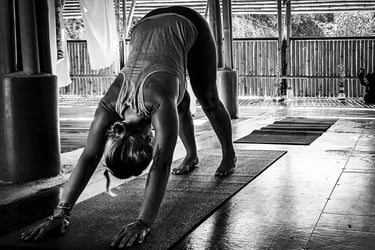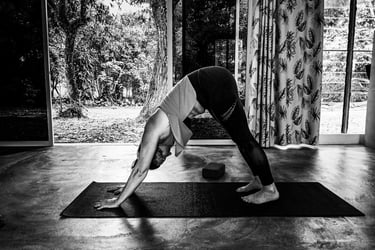Downward Dog : More Challenges
Downward Dog (Adho Mukha Svanasana) is one of yoga’s most recognised poses, offering a host of benefits for the mind and body. If you’re dealing with low back pain (LBP) or scoliosis, this pose can provide relief by gently stretching the spine and balancing muscular tension.
But for many, especially beginners, breathing deeply in this position can pose yet another challenge .


Downward Dog requires your diaphragm to move against gravity as you push it towards your pelvis. If you’re engaging your core - which is key for the pose’s benefits - it can feel even harder to find a steady, full breath. For those with scoliosis, the uneven development of muscles on either side of the spine may make the experience even more pronounced.
So how can you breathe better in this pose?
Dirga Pranayama trains you to breathe beyond your abdomen, expanding into your chest, ribs, and back. By consciously filling these areas with breath, you learn to utilise your full lung capacity.
For those with scoliosis, this practice helps you reconnect with underused muscles while relaxing overactive ones, creating a more balanced relationship between the two sides of your body. Over time, this kind of focused breathwork prepares you to breathe more effectively in Downward Dog, even when your core is engaged.
Steady breathing is key to holding Downward Dog long enough to experience its benefits, especially if you’re using the pose to manage pain or improve alignment.
For Low Back Pain: Downward Dog gently decompresses the spine, relieving pressure in the lower back. When paired with even, mindful breathing, it can help you release tension in tight areas and engage stabilising muscles.
For Scoliosis : Holding the pose with awareness allows you to feel and address the uneven pulling of muscles. The gentle traction through the spine, combined with a focus on balanced breath, encourages alignment and eases asymmetrical tension
The longer you hold Downward Dog, the more opportunity you have to stretch, strengthen, and realign - but only if you can breathe comfortably throughout.


The journey to breathing deeply in Downward Dog may take time, but it’s worth the effort. Practising Dirga Pranayama will help you expand your breath into new areas of your body, allowing you to hold the pose longer and enjoy its full benefits.
With patience and practice, Downward Dog can become a powerful tool in your routine for managing pain, finding balance, and reconnecting with your body.
More Insights
